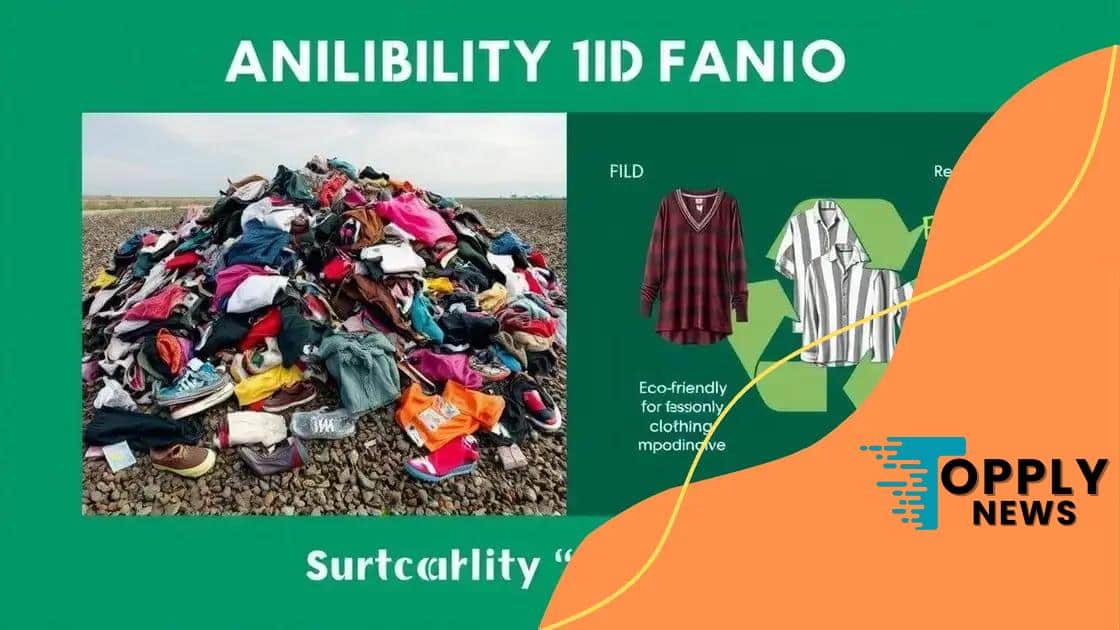The rise of fast fashion with Shein: what to know

The rise of fast fashion with Shein has significantly transformed consumer shopping habits, emphasizing affordability and rapid trends while raising sustainability concerns due to waste and ethical labor practices.
The rise of fast fashion with Shein has significantly reshaped how we approach clothing today. With its trendy pieces and affordable prices, it’s no wonder that shoppers often find themselves drawn to this brand. But what does it mean for the industry and for us as consumers?
Understanding the fast fashion model
Understanding the fast fashion model is essential to grasp its impact on the fashion industry. Fast fashion refers to the trend of quickly bringing affordable clothing to consumers, allowing them to enjoy the latest styles without breaking the bank.
This model thrives on speed and volume. Companies, like Shein, produce large quantities of clothing, ensuring that new items are frequently available. This continuous cycle encourages consumers to buy more, often leading to undesirable practices.
Characteristics of Fast Fashion
To better understand, let’s explore some defining characteristics of the fast fashion model:
- Rapid production cycles, often updating collections weekly.
- Affordable pricing to attract a broad consumer base.
- Emphasis on current trends and celebrity endorsements.
- Short-lived clothing items that prioritize style over quality.
This model has revolutionized the shopping experience. Consumers have become accustomed to high volumes of low-cost clothing. As a result, fast fashion retailers maintain a strong presence in the market.
Consumer Behavior and Fast Fashion
The rise of the internet and social media has fueled this phenomenon. Online shopping platforms like Shein make it easy to access the latest trends. With just a few clicks, consumers can purchase trendy clothes from the comfort of their homes.
However, this convenience has consequences. The constant influx of new items creates a culture of disposability. Shoppers may wear clothing just a few times before discarding it, contributing to significant waste.
While fast fashion seems appealing, it is vital to understand how it affects not only our wallets but also the environment. As more people become aware, many are now questioning their shopping habits and seeking more sustainable alternatives. In doing so, they can balance style with responsibility, aiming for fashion choices that are not only affordable but also ethical.
The impact of Shein on global fashion trends
The impact of Shein on global fashion trends is significant and cannot be overlooked. As one of the leading fast fashion brands, Shein has transformed the way people shop and how trends are defined. With its business model, Shein brings a plethora of styles to consumers quickly, which reshapes the fashion landscape.
One major impact is the speed at which styles change. Unlike traditional retail, where trends might linger for a season, Shein can introduce new items in a matter of days. This creates a culture where consumers expect fresh options regularly.
Shifting Consumer Expectations
Today’s shoppers are more accustomed to immediacy. With platforms like Shein leading the charge, the expectation is for brands to deliver the latest fashions at lightning speed. This shift has resulted in:
- Increased demand for constant updates in wardrobes.
- Higher pressure on brands to keep pace with rapidly changing trends.
- Consumers often prioritizing trends over quality.
- A notable rise in impulse buying habits.
This leads to a cycle where fashion becomes more about momentary satisfaction rather than lasting investment. Shein caters to this demand, offering clothing at prices that encourage purchasing without much thought.
Influence on Fashion Sustainability
However, Shein’s impact isn’t limited to just consumer behavior. It raises questions about sustainability in the fashion industry. The fast fashion model leads to significant waste, contributing to environmental issues. With clothing produced en masse, often with a focus on cheap materials, the long-term effects on our planet are concerning.
Additionally, this rapid production affects the craftsmanship that is lost in traditional fashion. As brands focus on speed, the intricate designs and quality craftsmanship take a backseat. More people are starting to recognize these issues, pushing for a more sustainable approach in shopping.
Despite the challenges, Shein’s influence prompts conversations around responsible fashion choices. Consumers are becoming more aware of their purchases and are beginning to prioritize sustainable brands, albeit slowly. Recognizing Shein’s impact on the market might inspire others to innovate responsibly.
Sustainability concerns surrounding Shein

Sustainability concerns surrounding Shein are becoming increasingly important as the brand grows. While Shein offers trendy and affordable clothing, the environmental impact of its fast fashion model raises significant questions.
The fast cycle of production and consumption leads to massive waste. Shein produces vast quantities of apparel in a short period, which often ends up in landfills after just a few uses. This constant turnover creates a throwaway culture, where clothing is seen as disposable rather than an investment.
Environmental Impact
The environmental footprint of fast fashion is alarming. Key issues include:
- High water consumption in manufacturing processes.
- Use of harmful chemicals that can pollute waterways.
- Textile waste, with millions of tons of clothing discarded each year.
- Carbon emissions associated with shipping products globally.
Moreover, Shein’s rapid production often comes at the cost of ethical labor practices. Reports highlight concerns about the working conditions in factories that supply these items, raising questions about the human cost of cheap clothing.
Consumer Awareness and Change
As awareness of these sustainability issues grows, consumers are beginning to reconsider their purchasing habits. Many are now seeking out brands that prioritize environmental responsibility and ethical labor. There is a push towards supporting sustainable fashion brands that use eco-friendly materials and fair labor practices.
This shift indicates a changing mentality among shoppers, who are placing greater value on the environmental and ethical implications of their fashion choices. By promoting sustainability, consumers can encourage brands like Shein to adopt more responsible practices.
Consumer behavior and fast fashion’s appeal
Consumer behavior and fast fashion’s appeal play a crucial role in the success of brands like Shein. Understanding why shoppers are drawn to fast fashion can help clarify the dynamics of the industry.
One of the main reasons consumers gravitate towards fast fashion is the affordability. Shein provides trendy clothing at prices that many can afford. This aspect makes it easy for people to keep their wardrobes updated without spending too much.
The Influence of Social Media
Another factor is the influence of social media. Platforms like Instagram and TikTok showcase the latest fashion trends, often featuring Shein’s clothing. Influencers promote these brands, which encourages their followers to try new styles. This creates a cycle where consumers feel pressure to keep up with trends.
Additionally, fast fashion thrives on the concept of immediacy. Shoppers no longer want to wait for seasons to change; they want to access new styles quickly. With Shein, they can do just that. This has changed how people approach fashion shopping, making it a more frequent and impulsive activity.
Emotional Connection and Self-Expression
Fast fashion also offers an avenue for self-expression. Many consumers view clothing as a way to showcase their personality and creativity. With a wide array of styles available, individuals can experiment with different looks without a significant financial commitment.
This sense of exploration fuels the desire to shop more frequently. However, while fast fashion allows for personal expression, it is important to be aware of the long-term implications on spending habits and sustainability.
The swift pace of purchasing can lead to buyers remorse, where consumers might regret their impulsive decisions later on. Recognizing this pattern is essential for making thoughtful fashion choices.
Alternatives to fast fashion for conscious shoppers
Alternatives to fast fashion for conscious shoppers have become increasingly vital as more people seek ethical and sustainable options. Recognizing the impact of fast fashion, many want to make better choices that align with their values.
One great alternative is to shop from sustainable fashion brands. Many companies focus on eco-friendly materials and ethical labor practices. Buying from these brands supports a positive impact on the environment and the communities involved in production.
Second-Hand Shopping
Another option is to explore second-hand shopping. Thrift stores, consignment shops, and online platforms for pre-owned clothing allow shoppers to find unique items while reducing waste. Buying used clothes is a wonderful way to give garments a second life and lessen the environmental impact.
Additionally, many thrift stores work to support local charities, making your purchases even more meaningful.
Renting Clothing
Clothing rental services have also gained popularity. These services let you rent outfits for special occasions without the need to buy items you might wear only once. Renting is both cost-effective and a sustainable choice, allowing you to enjoy new styles without contributing to fast fashion’s cycle.
Capsule Wardrobes
Creating a capsule wardrobe is another strategy. This involves curating a small collection of versatile pieces that mix and match well. By investing in quality over quantity, shoppers can minimize their impact and enjoy a more organized closet.
Conscious shoppers can also support local artisans and small businesses that offer handmade or locally sourced products. This practice not only helps the economy but ensures greater transparency regarding production methods.
As awareness grows, more people are making thoughtful choices with their fashion purchases. By choosing sustainable options, shoppers contribute to a more ethical and eco-friendly industry, paving the way for a brighter future in fashion.
FAQ – Frequently Asked Questions about Fast Fashion and Sustainable Alternatives
What is fast fashion?
Fast fashion refers to inexpensive clothing collections that are quickly produced to keep up with the latest trends, often at the cost of quality and ethical practices.
Why should I consider sustainable fashion alternatives?
Sustainable fashion alternatives reduce environmental impact and encourage ethical labor practices, allowing consumers to make more responsible choices.
How can shopping second-hand help the environment?
Shopping second-hand reduces textile waste by giving clothes a second life, decreasing the demand for new items and conserving resources.
What is a capsule wardrobe and its benefits?
A capsule wardrobe is a curated collection of versatile pieces that can be mixed and matched, promoting minimalism and thoughtful purchasing.





